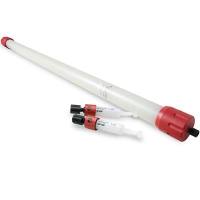RNA Secondary Structure Analysis Using the Vienna RNA Package
互联网
- Abstract
- Table of Contents
- Figures
- Literature Cited
Abstract
This unit documents how to use the Vienna RNA package for RNA secondary structure analysis. Possible tasks include structure prediction for single sequences, prediction of consensus structures, prediction of RNA?RNA interactions, and sequence design. Curr. Protoc. Bioinform. 26:12.2.1?12.2.16. © 2009 by John Wiley & Sons, Inc.
Keywords: structure prediction; secondary structure; RNA structure; consensus structure; sequence design; RNA interactions
Table of Contents
- Introduction
- Basic Protocol 1: Using the RNAfold Program to Predict RNA Secondary Structure
- Basic Protocol 2: Computing Consensus Structures
- Basic Protocol 3: Cofolding of Two RNA Molecules
- Alternate Protocol 1: Predicting RNA‐RNA Interactions Using RNAduplex and RNAup
- Basic Protocol 4: Inverse Folding
- Alternate Protocol 2: Using the Vienna RNA Websuite
- Support Protocol 1: Installing the Vienna RNA Package
- Guidelines for Understanding Results
- Commentary
- Literature Cited
- Figures
Materials
Figures
-
Figure 12.2.1 Sample session, computing the structure of a 5S rRNA. (A ) Input, (B ) secondary structure graph, (C ) dot plot, and (D ) mountain plot. Colors have been converted to patterns in this black and white reproduction of the mountain plot: solid line (black) represents pair probabilities; short dashes (red) represent mfe structure; dotted line (green) represents positional entropy; and long dashes (blue) represent the correct structure (for comparison). View Image -
Figure 12.2.2 RNAalifold sample session to predict the consensus structure of the HIV TAR element using the first 60 bases of 13 genomic HIV‐1 sequences. (A ) Command‐line input; (B ) the resulting consensus structure, and (C ) the AliDot.pl viewer. View Image -
Figure 12.2.3 Sample RNAcofold session that computes equilibrium concentrations of homo‐ and hetero‐dimers for several different input concentrations specified in the conc.txt input file. View Image -
Figure 12.2.4 Sample input file for RNAup and RNAduplex containing the sequence of human microRNA 145 and part of the messenger RNA for PARP‐8. View Image -
Figure 12.2.5 RNAduplex output for the two sequences shown in Figure . Position 16‐39 of the mRNAs sequence is predicted to bind nucleotide 1‐19 of the miRNA with an interaction energy of −21.8 kcal/mol. View Image -
Figure 12.2.6 RNAup prediction for the binding of the two sequences shown in Figure . View Image -
Figure 12.2.7 Using RNAinverse to design an artificial hammerhead ribozyme. (A ) Command‐line input, (B ) A dot plot of the correct mfe structure with many alternative foldings, and (C ) A dot plot of a sequence with an extremely well‐defined structure. View Image
Videos
Literature Cited
| Bernhart, S.H., Tafer, H., Mückstein, U., Flamm, Ch., Stadler, P.F., and Hofacker, I.L. 2006. Partition function and base pairing probabilities of RNA heterodimers. Algorithms Mol. Biol. 1:3. | |
| Flamm, C., Fontana, W., Hofacker, I.L., and Schuster, P. 2000. RNA folding at elementary step resolution. RNA 6:325‐338. | |
| Flamm, C., Hofacker, I.L., Stadler, P.F., and Wolfinger, M.T. 2002. Barrier trees of degenerate landscapes. Z. Phys. Chem. 216:155‐173. | |
| Gruber, A.R., Lorenz, R., Bernhart, S.H., Neuböck, R., and Hofacker, I.L. 2008. The Vienna RNA websuite. Nucl. Acids Res. Epub, April 19, 2008. | |
| Hofacker, I.L. and Stadler, P.F. 1999. Automatic detection of conserved base pairing patterns in RNA virus genomes. Comput. Chem. 23:401‐414. | |
| Hofacker, I.L., Fontana, W., Stadler, P.F., Bonhoffer, S., Tacker, M., and Schuster, P. 1994. Fast folding and comparison of RNA secondary structures (the Vienna RNA Package). Monath. Chem. 125:167‐188. | |
| Hofacker, I.L., Fekete, M., Flamm, C., Huynen, M.A., Rauscher, S., Stolorz, P.E., and Stadler, P.F. 1998. Automatic detection of conserved RNA structure elements in complete RNA virus genomes. Nucl. Acids Res. 26:3825‐3836. | |
| Hofacker, I.L., Fekete, M., and Stadler, P.F. 2002. Secondary structure prediction for aligned RNA sequences. J. Mol. Biol. 319:1059‐1066. | |
| Mathews, D., Sabina, J., Zucker, M., and Turner, H. 1999. Expanded sequence dependence of thermodynamic parameters provides robust prediction of RNA secondary structure. J. Mol. Biol. 288:911‐940. | |
| McCaskill, J. 1990. The equilibrium partition function and base pair binding probabilities for RNA secondary structure. Biopolymers 29:1105‐1119. | |
| Mückstein, U., Tafer, H., Hackermüller, J., Bernhart, S.H., Stadler, P.F., and Hofacker, I.L. 2006. Thermodynamics of RNA‐RNA binding. Bioinformatics 22:1177‐1182. | |
| Schuster, P., Fontana, W., Stadler, P.F., and Hofacker, I.L. 1994. From sequences to shapes and back: A case study in RNA secondary structures. Proc. R. Soc. London B Biol. Sci. 255:279‐284. | |
| Shapiro, B. and Zhang, K. 1990. Comparing multiple RNA secondary structures using tree comparisons. Comput. Appl. Biosci. 6:309‐318. | |
| Walter, A.E., Turner, D.H., Kim, J., Lyttle, M.H., Muller, P., Mathews, D.H., and Zuker, M. 1994. Coaxial stacking of helixes enhances binding of oligoribonucleotides and improves predictions of RNA folding. Proc. Natl. Acad. Sci. U.S.A. 91:9218‐9222. | |
| Wuchty, S., Fontana, W., Hofacker, I.L., and Schuster, P. 1999. Complete suboptimal folding of RNA and the stability of secondary structures. Biopolymers 49:145‐165. | |
| Zuker, M. 1989. On finding all suboptimal foldings of an RNA molecule. Science 244:48‐52. | |
| Zuker, M. and Stiegler, P. 1981. Optimal computer folding of larger RNA sequences using thermodynamics and auxiliary information. Nucl. Acids Res. 9:133‐148. | |
| Key References | |
| Hofacker, I.L. 2003. The Vienna RNA secondary structure server. Nucl. Acids Res. 31:3429‐3431. | |
| Describes how to perform several of the functions discussed in this unit on the Web using the Vienna RNA server. | |
| Hofacker et al., 1994. See above. | |
| The paper describing the first release of the Vienna RNA package, including a description of the underlying algorithm. | |
| Internet Resources | |
| http://www.tbi.univie.ac.at/∼ivo/RNA/ | |
| Site at which to download the latest version of the Vienna RNA package and read online manuals. | |
| http://rna.tbi.univie.ac.at/ | |
| Web interfaces to several of the Vienna RNA programs. |









